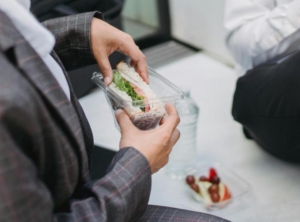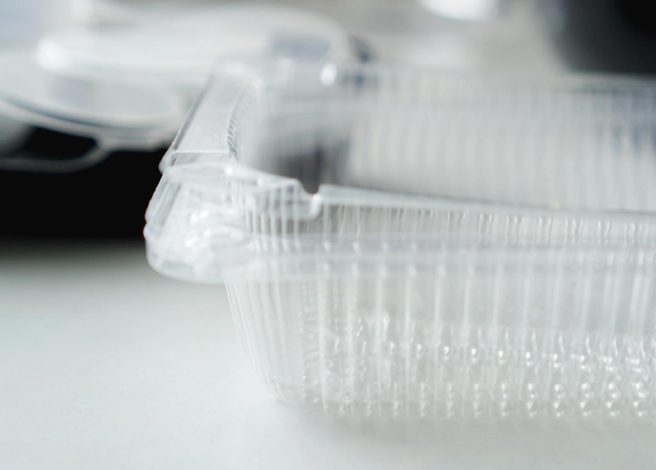Imagine, to your horror, a customer reaching into their takeout bag, only to discover your signature chicken marsala has betrayed them. The container sits cracked and defeated, rich sauce seeping into their car upholstery. Or picture vibrant, meticulously crafted salads languishing in your display case, their fresh ingredients hidden behind foggy containers. Even worse: (get ready) Think about the disaster of serving hot soup in containers that warp or melt when reheated — potentially causing harm to a customer! These aren’t hypotheticals. They’re real results of choosing the wrong food packaging. In today’s food retail market, a bad experience can damage online reviews and cause a loss of revenue. So, it’s important to know the differences between PET and polypropylene packaging when used in your business. Your choice could be quietly costing you customers and profits without you even realizing it.
Don’t worry; we at Inline Plastics are here to help. With over half a century of industry experience, we’ve found the right packaging solutions for businesses just like yours.
Today, we will explore the key distinctions between PET and polypropylene food packaging. You’ll discover why this knowledge matters for sustained success. Industry leaders know that excellence extends beyond the perfect recipe.
The Evolution of Food Packaging
Gone are the days when food packaging was just about transport. As consumer expectations have evolved, so has the science of food packaging.
Welcome PET and PP to the chat. They have changed how we package, present, and preserve food. Think of them as the dynamic duo of food packaging, each with its own superpower. Just as you wouldn’t send Batman to try and outrun The Flash, each packaging challenge demands its perfect match. It can mean the difference between a solution that simply works and one that makes your food shine.
Understanding PET: The Crystal-Clear Challenger
 Let’s put these materials in a boxing (or packaging!) ring. In one corner, we have polyethylene terephthalate (don’t worry, we will never ask you to pronounce it), more commonly known as PET. Here’s what this package brings to the ring:
Let’s put these materials in a boxing (or packaging!) ring. In one corner, we have polyethylene terephthalate (don’t worry, we will never ask you to pronounce it), more commonly known as PET. Here’s what this package brings to the ring:
- It’s clear: PET is known for its clarity and freshness in food. Its transparency makes it a top choice for businesses. This material has found its sweet spot in grocery store settings, especially in produce departments, bakeries, and deli sections.
- It keeps food fresh: It also protects the product with effective moisture barriers. This trait is key for businesses with premium produce or salads. Product presentation is as important as preservation.
- It’s both light-weight and strong: This combo make it ideal for grab-and-go use. Delis and quick-service places benefit from PET’s durability. It won’t hurt the visual appeal that drives impulse buys (you know, those gummy bears at the register calling your name).
- It can handle the cold: Its stability at room and cooler temperatures makes it ideal for refrigerated display cases. These packages can even withstand temperatures as low as zero degrees Fahrenheit!
- It’s inexpensive: Cost considerations often make PET the preferred choice for many applications. It is generally more affordable than polypropylene, making it an excellent option for high-volume operations. PET’s low cost and good performance make it the top choice for many food retail applications that don’t need heat resistance.
Like every fighter, PET does have a weakness: hot temperatures. This particular material will not hold up under heat lamps and with hot food applications. If you’re looking to package hot or ready-to-heat foods, you might want to consider this next contender.
Understanding Polypropylene: The Heat-Resistant Heavyweight
 In the other corner of our boxing ring is polypropylene (these pronunciations, come on! Let’s stick to calling it PP). This material has carved out a crucial niche in the food packaging industry, particularly in applications where thermal performance is key. That’s right; we’re talking heat! Knowing PP’s strengths can help business owners decide when to use this slightly more expensive but versatile material. Let’s highlight what makes this material a force to be reckoned with:
In the other corner of our boxing ring is polypropylene (these pronunciations, come on! Let’s stick to calling it PP). This material has carved out a crucial niche in the food packaging industry, particularly in applications where thermal performance is key. That’s right; we’re talking heat! Knowing PP’s strengths can help business owners decide when to use this slightly more expensive but versatile material. Let’s highlight what makes this material a force to be reckoned with:
- It can take the heat: Restaurants and food service operations that package hot foods for takeout or delivery find PP’s ability to maintain structural integrity at elevated temperatures invaluable.
- It’s not afraid of the microwave: This characteristic extends to microwave reheating, making it the only choice for businesses whose products will likely be reheated by consumers. Could the material even hold up to a ride in the dishwasher?
- Chemical resistance: PP is ideal for products with specific preservation requirements. Yogurt manufacturers, for instance, rely on PP’s ability to maintain product integrity when in contact with active cultures and preservatives. This chemical stability ensures that the packaging doesn’t interact with the product, maintaining safety and quality throughout its shelf life.
Making the Right Choice for Your Business
The decision between PET and PP should be guided by a thorough understanding of your product’s requirements and your customers’ needs.
Temperature Performance:
- PP excels in hot applications but becomes notably brittle in freezing conditions (environments colder than a standard home freezer).
- PET holds colder or room-temperature food beautifully, but melts dramatically in the microwave.
Material Characteristics:
- PET containers deliver outstanding clarity for product visibility.
- PP is resistant to many chemicals, which means it can safely package products with active cultures or preservatives without interacting with the food. This ensures the safety and quality of the product throughout its shelf life.
When counting costs, you must consider everything. This includes storage, transport, and any damage. PET might seem economical at first glance, giving you more bang for your buck. But PP’s toughness when things get heated might make it your champion in the long run.
Playing the Long Game: Think Beyond the Box
 Your packaging decisions impact every stage of your operation, not just the moment of sale. For takeout restaurants, PP is essential despite the higher cost — your customers need to reheat their meals safely at home. But if you’re showcasing fresh salads or deli items, PET’s crystal clarity and lower cost make more sense.
Your packaging decisions impact every stage of your operation, not just the moment of sale. For takeout restaurants, PP is essential despite the higher cost — your customers need to reheat their meals safely at home. But if you’re showcasing fresh salads or deli items, PET’s crystal clarity and lower cost make more sense.
Storage and display environments matter just as much. Consider your entire process: how long products sit in cold storage, how they’re transported, and how they’re displayed. Running multiple product lines? You might need both materials, each serving its purpose in your operation. The right choice protects your food, pleases your customers, and ultimately saves money through reduced waste and returns.
Putting A Lid on It
Choosing between PET and PP comes down to knowing what you’re serving up and how your customers want to enjoy it. While your competition might be learning about melted containers the hard way, you now know better.
The right packaging does more than just hold your food — it keeps your product looking good, your customers happy, and your reviews glowing. And the next time someone starts talking about polymers and packaging materials at a party (you know…that guy!), you’ll actually know what they’re talking about.
Looking for clarity? We will help you explore all your options — even ones that don’t include Inline Plastics. Let’s discuss what is best for you.


